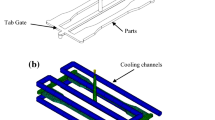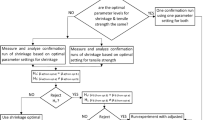Abstract
The injection molded housing part with thin shell feature could be produced to increase the internal space for packing more components. In this study, injection velocity, packing pressure, mold temperature, and melt temperature were selected as effective parameters for injection molding process. For the purpose of reducing dimension shrinkage variation of thin shell molded part, the response surface methodology was utilized to determine the relationship between input parameters and responses. Then the optimization condition was obtained according to the desirability function. Results show that melt temperature is the most significant factor on dimension shrinkage variation in transverse direction, followed by packing pressure, mold temperature, and injection velocity. However, in the longitudinal direction, packing pressure has the greatest influence on the dimension shrinkage variation, followed by injection velocity, melt temperature, and mold temperature. In accordance with verification experiments, the difference between the experimental data and predicted values ranges from −9.8% to 1.8%. To obtain the optimal condition, the overall desirability must be larger than 0.9. Based on analysis of variance, the proposed models look reasonably accurate.
Similar content being viewed by others
References
Ozcelik B, Erzurumlu T (2005) Determination of effecting dimensional parameters on warpage of thin shell plastic part using integrated response surface method and genetic algorithm. Int Commun Heat Mass Transf 32:1085–1094. doi:10.1016/j.icheatmasstransfer.2004.10.032
Galantucci LM, Spina R (2003) Evaluation of filling conditions of injection moulding by integrating numerical simulations and experimental tests. J Mater Process Technol 142:266–275. doi:10.1016/S0924-0136(03) 00276-0
Shen C, Wang L, Li Q (2007) Optimization of injection molding process parameters using combination of artificial neural network and genetic algorithm method. J Mater Process Technol 183:412–418. doi:10.1016/j.jmatprotec.2006.10.036
Shen YK, Wu CW, Yu YF, Chung HW (2008) Analysis for optimal gate design of thin-walled injection molding. Int Commun Heat Mass Transf 35:728–734. doi:10.1016/j.icheatmasstransfer.2008.01.014
Shen YK, Yeh PH, Wu JS (2001) Numerical simulation for thin wall injection molding of fiber-reinforced thermoplastics. Int Commun Heat Mass Transf 28:1035–1042. doi:10.1016/S0735-1933(01) 00307-4
Huang MC, Tai CC (2001) The effective factors in the warpage problem of an injection-molded part with a thin shell feature. J Mater Process Technol 110:1–9. doi:10.1016/S0924-0136(00) 00649-X
Tang SH, Tan YJ, Sapuan SM, Sulaiman S, Ismail N, Samin R (2007) The use of Taguchi method in the design of plastic injection mould for reducing warpage. J Mater Process Technol 182:418–426. doi:10.1016/j.jmatprotec.2006.08.025
Park K, Ahn JH (2004) Design of experiment considering two-way interactions and its application to injection molding processes with numerical analysis. J Mater Process Technol 146:221–227. doi:10.1016/j.jmatprotec.2003.10.020
Choi DS, Im YT (1999) Prediction of shrinkage and warpage in consideration of residual stress in integrated simulation of injection molding. Compos Struct 47:655–665. doi:10.1016/S0263-8223(00) 00045-3
Myers RH, Montgomery DH (1995) Response surface methodology. Wiley, USA
Chiang KT (2007) Modeling and optimization of designing parameters for a parallel-plain fin heat sink with confined impinging jet using the response surface methodology. Appl Therm Eng 27:2473–2482. doi:10.1016/j.applthermaleng.2007.02.004
Kurtaran H, Erzurumlu T (2006) Efficient warpage optimization of thin shell plastic parts using response surface methodology and genetic algorithm. Int J Adv Manuf Technol 27:468–472. doi:10.1007/s00170-004-2321-2
Derringer G, Suich R (1980) Simultaneous optimization of several response variables. J Qual Technol 12:214–219
Moldflow Plastics Insight Release 5.0 (2004)
Author information
Authors and Affiliations
Corresponding author
Rights and permissions
About this article
Cite this article
Chen, CC., Su, PL. & Lin, YC. Analysis and modeling of effective parameters for dimension shrinkage variation of injection molded part with thin shell feature using response surface methodology. Int J Adv Manuf Technol 45, 1087 (2009). https://doi.org/10.1007/s00170-009-2045-4
Received:
Accepted:
Published:
DOI: https://doi.org/10.1007/s00170-009-2045-4




